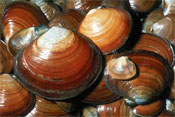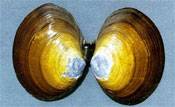Varnish Clam

Photo: Varnish clams. Photo Graham Gillespie.
Latin Name
Nuttallia obscurata
Group Name
Molluscs
Species Description
This recently introduced Japanese species has been reported in increasing numbers since the early 1990's. The varnish clam (Nuttallia obscurata) has been reported form beaches in Puget Sound, Sooke and as far north as Manson's Landing on Cortes Island. Sightings have been recorded in 1997 from Barkley Sound on the West Coast of Vancouver Island. A huge increase in varnish clams at Savary Island has been noted between clam surveys undertaken in 1995 and 1998 (G. Gillespie, pers comm).
Species Biology

Photo: Open Varnish clam. Photo Graham Gillespie
Varnish clams are capable of filter-feeding, selectively removing food particles from the water column. They also utilize pedal feeding, collecting organic detritus from the sediment using the foot.
Little is known about age and growth of varnish clams, but there is evidence that they may grow at rates similar to Manila clams, Venerupis philippinarum, achieving 38 mm in length in about four years. Size and age at maturity are not known but is currently being investigated.
Anecdotal and survey information indicate that varnish clams have established fairly large populations on most beaches in Georgia Strait in a relatively short time (< 10 yr).
Varnish clams are typically found associated with manila, littleneck (Protothaca staminea), softshell (Mya arenaria), and macoma clams. They are host to pea crabs, Pinnixia faba, sometimes with relatively high infestation rates. These crabs are found in other intertidal clams, but generally mature only in horse clams, Tresus capax.
Varnish clams are preyed on by moonsnails (Euspira lewisi), crabs, gulls, crows (Corvus caurinus) and oystercatchers (Haematopus bachmani).
Fishery
Following resolution of public health concerns regarding risks associated with Paralytic Shellfish Poisoning (PSP) and coliform contamination by the Canadian Food Inspection Agency (CFIA), varnish clams were harvested on a small scale under experimental licence. The purpose of the project was to collect biological data and test marketability. Studies included the documentation of harvesting techniques and processing methods, and experiments to examine competition between varnish and Manila clams.
Limited information gathered by the CFIA indicate that varnish clams accumulate and depurate PSP toxins at rates similar to Manila clams and Pacific oysters (Crassostrea gigas).
Limited landings of varnish clams were also harvested during an experimental opening in the wild commercial clam fishery in 2001 during which the retention of varnish clams was permitted.
The market name "Savoury Clam" has been registered with the CFIA for the purpose of an international marketing study. Results of the market study show interest from both Canadian and U.S. restaurant markets.
Varnish clams are fished recreationally, but effort, landings or relative importance in the recreational fishery is not known.
- Date modified: